

Figure 8 puffer
(Dichotomyctere ocellatus)
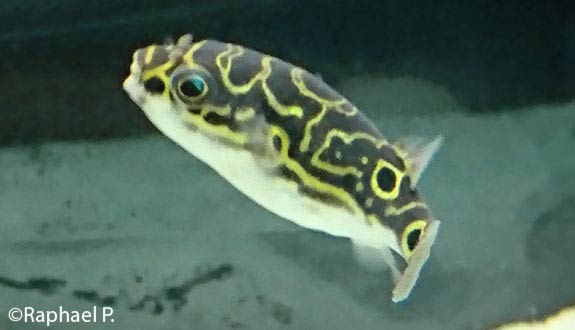
Many thanks to Raphaël for writing this sheet!
Alternative species (click on the thumbnail to see the card)
Names
Scientific name
Dichotomyctere ocellatus
Common name
Figure 8 puffer
Eight-Puffer
Eyespot puffer
Origin

Origin: Southeast Asia (estuary, brackish waters)
Biotope: Not specific
Dimorphism

Sexual dimorphism can only be seen from an older age
Group

Tetraodontidae
Volume

60 L / 13 imp gal / 16 US gal per individual
Parameters

T°: 24 à 28°C or 75 to 82°F
pH: 6.7 to 7.5
Hardness: 5 to 15°dGH
Difficulty

Average
Size

6 to 8 cm (2.36 to 3.15")
Longevity

6 to 8 years
Living zone
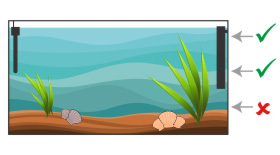
Middle and Depth
Individuals

1
Food
How to feed the Figure 8 puffer?
Food
How to feed the Figure 8 puffer?
Tetraodon Biocellatus is molluscivorous, that is, its basic diet is composed of molluscs. In addition to being very fond of small snails, these are essential for the Tetraodon: they use their teeth that grow continuously. Without this, the fish may have difficulty feeding and eventually cause premature death.
Juvenile, feed it with frozen food.
Behavior
What kind of behavior does the Figure 8 puffer have?
Behavior
What kind of behavior does the Figure 8 puffer have?
This Tetraodon is one of the most peaceful of this family of fish. Note that this peaceful behaviour is only valid if it is well fed, otherwise it is quite possible that it attacks other fish that are slower or smaller.
It usually spends its time crossing the aquarium in length and watching what is happening around him. It also makes many trips back and forth between the top and bottom of the tank. In fact, it patrols and looks for a small misplaced mollusk.
The Tetraodon has eyes that move independently of each other: it’s pretty funny to watch!
This species is very intelligent, it is quite capable of assimilating the face of its feeder and to recognise it. The fish can also refuse to feed if the person who feeds them is not the usual person!
Cohabitation
Who can live with the Figure 8 puffer?
Cohabitation
Who can live with the Figure 8 puffer?
Like all Tetraodons, it is best to maintain them in a specific aquarium. However, it is possible to coexist with other species of brackish water, like the Archerfish (Toxotes jaculatrix).
Breeding
How to breed the Figure 8 puffer?
Breeding
How to breed the Figure 8 puffer?
Almost impossible in an aquarium.
Its aquarium
Which aquarium for the Figure 8 puffer?
Its aquarium
Which aquarium for the Figure 8 puffer?
The Biocellatus tetraodon is a brackish water fish. It is true that it can live in FRESHWATER but this will have inevitable consequences on its health: sensitivity to increased diseases and premature death are the main problems encountered.
In an aquarium, you can keep a Biocellatus 1 to 2 years in FRESHWATER. After this age, start tipping the tray in brackish water. For this, increase the salinity of the water with salts for marine aquarium. Attention, the rise will have to be very progressive and to be spread over several months.
The final density of the aquarium should be between 1005 and 1015. A density of 1008 is a good compromise because it allows some plants to acclimatise smoothly and survive. Beyond this value no freshwater plant will survive.
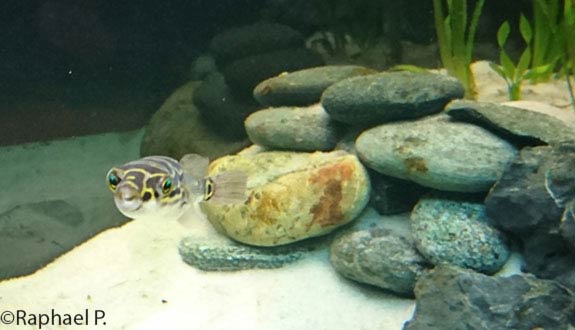
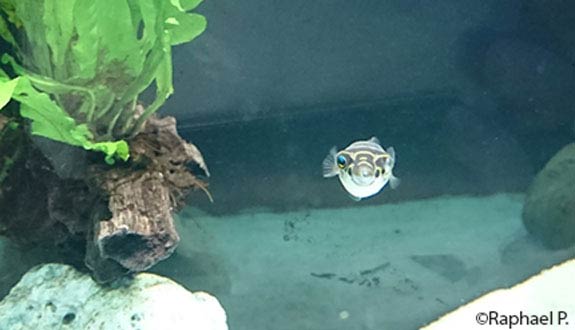
Good To know
Find all additional information!
Good To know
Find all additional information!
Tetraodons have a strong jaw that is part of their skeleton. This jaw grows continuously (like that of rabbits) and needs to be worn so that the fish can continue to feed properly, otherwise it can prevent it from feeding, and finally kill it.
CAUTION: Tetraodons are derived from globose fish, similar to Fugu. One of their common features is the presence in their viscera of Tetrodotoxin, a deadly toxin if ingested in sufficient doses and without any cure to date. This peculiarity requires vigilance, even with our aquarium fish. Indeed, they can in some cases secrete, especially during a heavy stress or spawning. It is not uncommon to have losses among the other species of the tank when this happens. In case of death of a Tetraodon, avoid siphoning the tank by sucking the water with your mouth (even if the quantities are tiny, it is better not to take the risk).
It is nicknamed the "Eight-Puffer" in English because of the "8" drawings on his back:
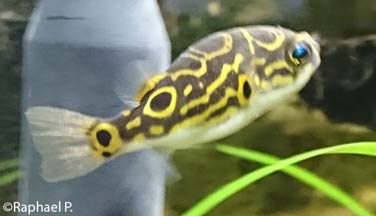
Yours photos!
Comments
Sort by:
Please login to post comments
